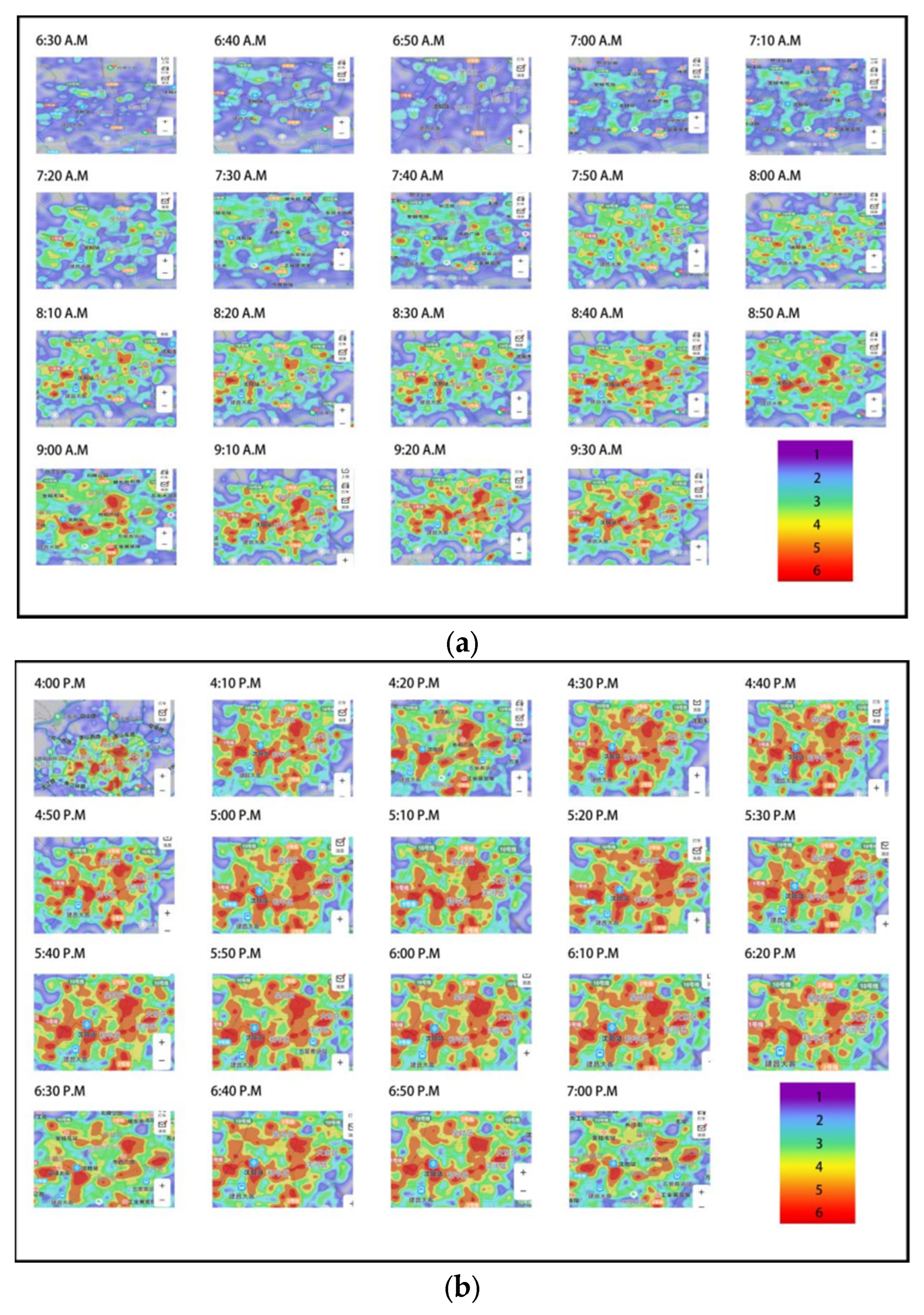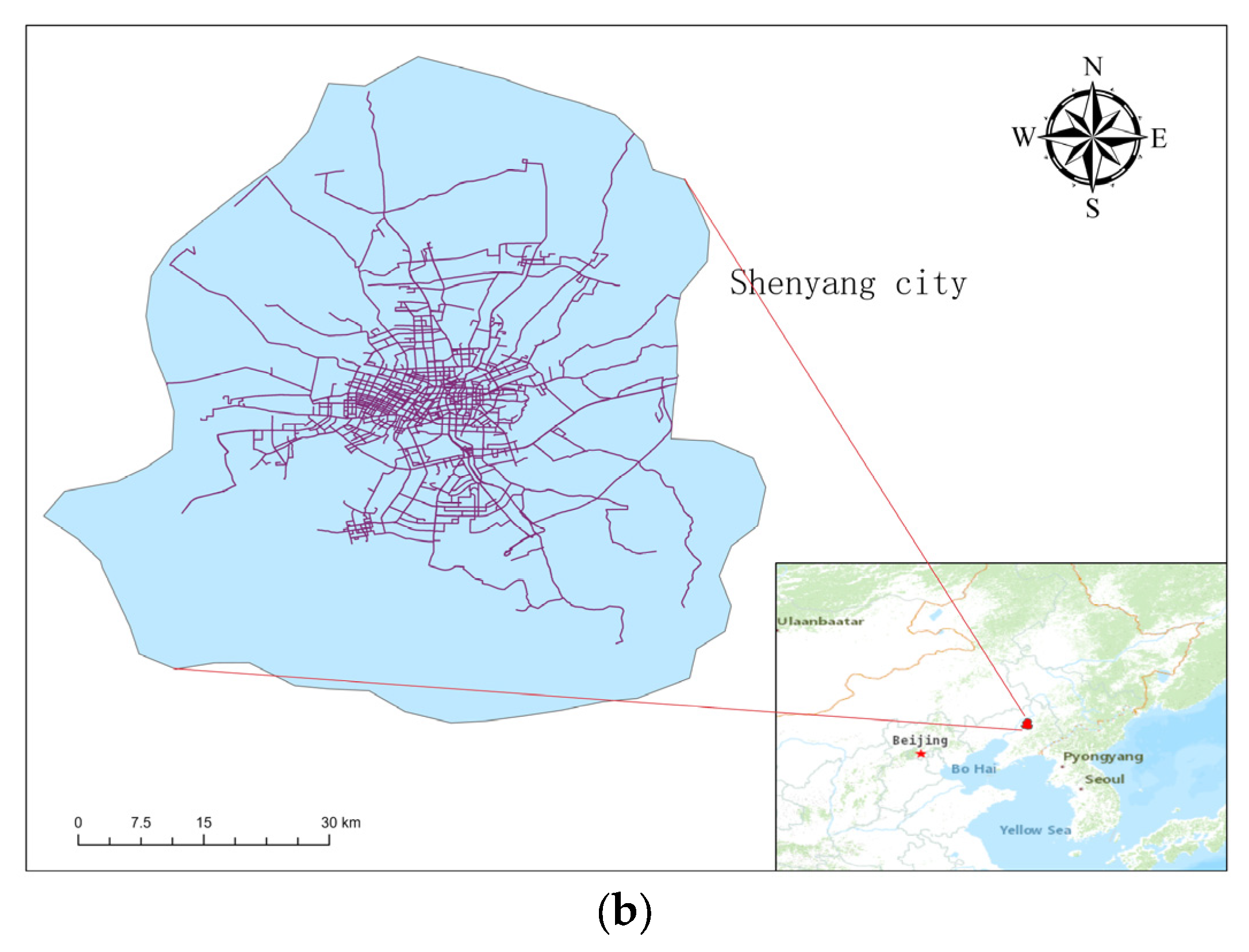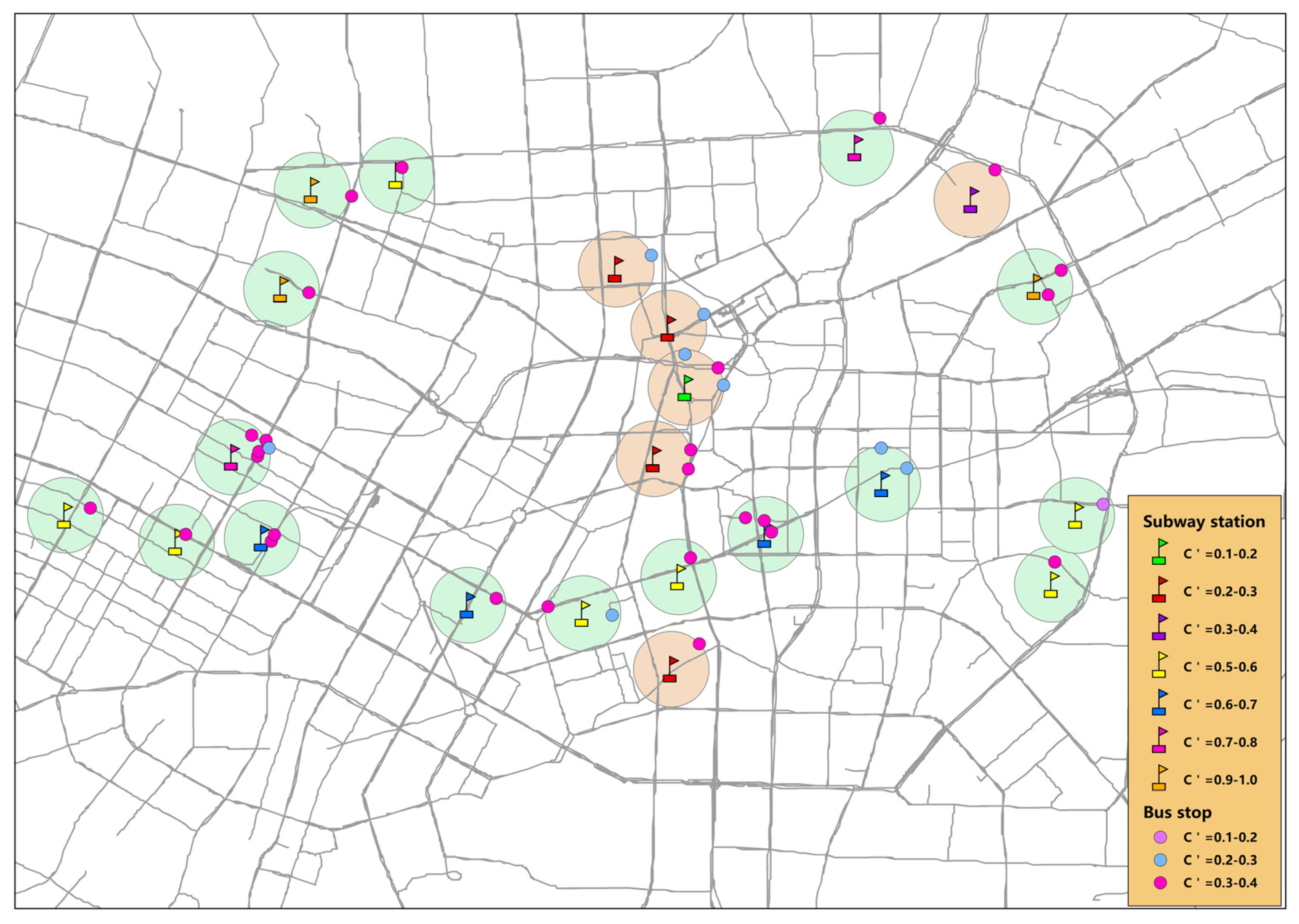A Coupling Model for Measuring the Substitution of Subways for Buses during Snowstorms: A Case Study of Shenyang, China
Abstract
:1. Introduction
2. Data and Method
2.1. Data Sources
2.1.1. Population Flow Data
2.1.2. Subway and Bus Networks Data
2.2. Building the Subway and Bus Networks
2.3. Performing the Network Analysis
2.4. Building the Coupling Model
3. Results
3.1. Network Analysis of Subway and Bus Networks
3.1.1. Network Analysis of the Subway Network
3.1.2. Network Analysis of the Bus Network
3.2. Coupling Analysis of Subway and Bus Networks
4. Discussion and Conclusions
Author Contributions
Funding
Institutional Review Board Statement
Informed Consent Statement
Data Availability Statement
Conflicts of Interest
References
- Chopra, S.S.; Dillon, T.; Bilec, M.M.; Khanna, V. A network-based framework for assessing infrastructure resilience: A case study of the London metro system. J. R. Soc. Interface 2016, 13, 20160113. [Google Scholar] [CrossRef]
- Handy, S.; Weston, L.; Mokhtarian, P.L. Driving by choice or necessity? Transp. Res. Part A Policy Pract. 2005, 39, 183–203. [Google Scholar] [CrossRef]
- Heinen, E.; Van Wee, B.; Maat, K. Commuting by bicycle: An overview of the literature. Transp. Rev. 2010, 30, 59–96. [Google Scholar] [CrossRef]
- Mitra, R. Independent mobility and mode choice for school transportation: A review and framework for future research. Transp. Rev. 2013, 33, 21–43. [Google Scholar] [CrossRef]
- Camagni, R.; Gibelli, M.C.; Rigamonti, P. Urban mobility and urban form: The social and environmental costs of different patterns of urban expansion. Ecol. Econ. 2002, 40, 199–216. [Google Scholar] [CrossRef]
- Newman, P.; Kenworthy, J. Urban design to reduce automobile dependence. Opolis 2006, 2, 35–52. [Google Scholar]
- Mu, R.; de Jong, M. Establishing the conditions for effective transit-oriented development in China: The case of Dalian. J. Transp. Geogr. 2012, 24, 234–249. [Google Scholar] [CrossRef]
- Morgan, A.; Mannering, F. The effects of road-surface conditions, age, and gender on driver-injury severities. Accid. Anal. Prev. 2011, 43, 1852–1863. [Google Scholar] [CrossRef]
- Zhang, J.; Liu, S.; Liang, H.; Wan, W.; Guo, Z.; Liu, B. Using GNSS-IR Snow Depth Estimation to Monitor the 2022 Early February Snowstorm over Southern China. Remote Sens. 2022, 14, 4530. [Google Scholar] [CrossRef]
- Hamzeie, R.; Savolainen, P.T.; Gates, T.J. Driver speed selection and crash risk: Insights from the naturalistic driving study. J. Saf. Res. 2017, 63, 187–194. [Google Scholar] [CrossRef]
- Molarius, R.; Keränen, J.; Kekki, T.; Jukarainen, P. Developing Indicators to Improve Safety and Security of Citizens in Case of Disruption of Critical Infrastructures Due to Natural Hazards—Case of a Snowstorm in Finland. Safety 2022, 8, 60. [Google Scholar] [CrossRef]
- Call, D.A.; Medina, R.M.; Black, A.W. Causes of Weather-Related Crashes in Salt Lake County, Utah. Prof. Geogr. 2019, 71, 253–264. [Google Scholar] [CrossRef]
- Knoppers, P.; Muller, T. Optimized transfer opportunities in public transport. Transp. Sci. 1995, 29, 101–105. [Google Scholar] [CrossRef]
- Spencer, A.H.; Andong, W. Light rail or busway? A comparative evaluation for a corridor in Beijing. J. Transp. Geogr. 1996, 4, 239–251. [Google Scholar] [CrossRef]
- Nie, C.; Wen, H.; Fan, X.-F. The spatial and temporal effect on property value increment with the development of urban rapid rail transit: An empirical research. Geogr. Res. 2010, 29, 801–810. [Google Scholar]
- Salon, D.; Wu, J.; Shewmake, S. Impact of bus rapid transit and metro rail on property values in Guangzhou, China. Transp. Res. Rec. 2014, 2452, 36–45. [Google Scholar] [CrossRef]
- Tong, H.; Dong, X.; Liu, J. Optimization Method for Land Use of the Xi’an Rail Transit Station Area Based on a Multi-Objective Model. Land 2023, 12, 1705. [Google Scholar] [CrossRef]
- Cervero, R. Linking urban transport and land use in developing countries. J. Transp. Land Use 2013, 6, 7–24. [Google Scholar] [CrossRef]
- Hou, Q.; Duan, Y.; Ma, R. Collaborative optimization of land use intensity and traffic capacity under hierarchical control rules of regulatory detailed planning. J. Chang. Univ. 2015, 35, 114–121. [Google Scholar]
- Astegiano, P.; Tampère, C.M.; Beckx, C. A preliminary analysis over the factors related with the possession of an electric bike. Transp. Res. Procedia 2015, 10, 393–402. [Google Scholar] [CrossRef]
- Hiselius, L.W.; Svensson, Å. E-bike use in Sweden–CO2 effects due to modal change and municipal promotion strategies. J. Clean. Prod. 2017, 141, 818–824. [Google Scholar] [CrossRef]
- Sun, Q.; Feng, T.; Kemperman, A.; Spahn, A. Modal shift implications of e-bike use in the Netherlands: Moving towards sustainability? Transp. Res. Part D Transp. Environ. 2020, 78, 102202. [Google Scholar] [CrossRef]
- Fearnley, N.; Currie, G.; Flügel, S.; Gregersen, F.A.; Killi, M.; Toner, J.; Wardman, M. Competition and substitution between public transport modes. Res. Transp. Econ. 2018, 69, 51–58. [Google Scholar] [CrossRef]
- Petit, A.; Lei, C.; Ouyang, Y. Multiline Bus Bunching Control via Vehicle Substitution. Transp. Res. B-Methodol. 2019, 126, 68–86. [Google Scholar] [CrossRef]
- Chalermpong, S.; Kato, H.; Thaithatkul, P.; Ratanawaraha, A.; Fillone, A.; Hoang-Tung, N.; Jittrapirom, P. Ride-hailing applications in Southeast Asia: A literature review. Int. J. Sustain. Transp. 2023, 17, 298–318. [Google Scholar] [CrossRef]
- Grayling, T.; Glaister, S. A New Fares Contract for London; Institute for Public Policy Research: London, UK, 2000. [Google Scholar]
- Castillo-Manzano, J.I.; Pozo-Barajas, R.; Trapero, J.R. Measuring the substitution effects between high speed rail and air transport in Spain. J. Transp. Geogr. 2015, 43, 59–65. [Google Scholar] [CrossRef]
- Bigazzi, A.; Wong, K. Electric bicycle mode substitution for driving, public transit, conventional cycling, and walking. Transp. Res. Part D Transp. Environ. 2020, 85, 102412. [Google Scholar] [CrossRef]
- Montgomery, B.N. Cycling trends and fate in the face of bus rapid transit: Case study of Jinan, Shandong Province, China. Transp. Res. Rec. 2010, 2193, 28–36. [Google Scholar] [CrossRef]
- Mitra, R.; Ziemba, R.A.; Hess, P.M. Mode substitution effect of urban cycle tracks: Case study of a downtown street in Toronto, Canada. Int. J. Sustain. Transp. 2017, 11, 248–256. [Google Scholar] [CrossRef]
- Sun, C.; Zhang, W.; Luo, Y.; Xu, Y. The improvement and substitution effect of transportation infrastructure on air quality: An empirical evidence from China’s rail transit construction. Energy Policy 2019, 129, 949–957. [Google Scholar] [CrossRef]
- Zhou, Y.; Yu, Y.; Wang, Y.; He, B.; Yang, L. Mode substitution and carbon emission impacts of electric bike sharing systems. Sustain. Cities Soc. 2023, 89, 104312. [Google Scholar] [CrossRef]
- Polydoropoulou, A.; Ben-Akiva, M. Combined revealed and stated preference nested logit access and mode choice model for multiple mass transit technologies. Transp. Res. Rec. 2001, 1771, 38–45. [Google Scholar] [CrossRef]
- Rich, J.; Mabit, S.L. A long-distance travel demand model for Europe. Eur. J. Transp. Infrastruct. Res. 2012, 12, 10–12. [Google Scholar] [CrossRef]
- Strano, E.; Shai, S.; Dobson, S.; Barthelemy, M. Multiplex networks in metropolitan areas: Generic features and local effects. J. R. Soc. Interface 2015, 12, 20150651. [Google Scholar] [CrossRef] [PubMed]
- Hu, B.; Xu, A.; Dong, X. Evaluating the Comprehensive Development Level and Coordinated Relationships of Urban Multimodal Transportation: A Case Study of China’s Major Cities. Land 2022, 11, 1949. [Google Scholar] [CrossRef]
- Mao, Q.; Li, N. Assessment of the impact of interdependencies on the resilience of networked critical infrastructure systems. Nat. Hazards 2018, 93, 315–337. [Google Scholar] [CrossRef]
- Akin, D. Model for Estimating Increased Ridership Caused by Integration of Two Urban Transit Modes: Case Study of Metro and Bus–Minibus Transit Systems, Istanbul, Turkey. Transp. Res. Rec. 2006, 1986, 162–171. [Google Scholar] [CrossRef]
- Cheng, X.; Long, R.; Chen, H.; Li, Q. Coupling coordination degree and spatial dynamic evolution of a regional green competitiveness system–A case study from China. Ecol. Indic. 2019, 104, 489–500. [Google Scholar] [CrossRef]
- Tang, Z. An integrated approach to evaluating the coupling coordination between tourism and the environment. Tour. Manag. 2015, 46, 11–19. [Google Scholar] [CrossRef]
- Xue, F.; He, C.; Huang, Q.; Luo, J. Coordination degree of multimodal rail transit network. J. Jilin Univ. 2021, 51, 2040–2050. [Google Scholar]
- Li, X.; Dai, Z.; Li, H.; Hu, J. Joint Optimization of Urban Rail Transit and Local Bus Transit:Continuous Approximation Approach. J. Transp. Syst. Eng. Inf. Technol. 2022, 22, 206–213+246. [Google Scholar]
- Chen, X.; Li, Y.; Shen, Q.; Ju, Y. Urban traffic networks collaborative optimization method based on two-layered complex networks. J. Comput. Appl. 2019, 39, 3079–3087. [Google Scholar]
- Chen, X.; Wang, Z.; Hua, Q.; Shang, W.-L.; Luo, Q.; Yu, K. AI-Empowered Speed Extraction via Port-Like Videos for Vehicular Trajectory Analysis. IEEE Trans. Intell. Transp. Syst. 2023, 24, 4541–4552. [Google Scholar] [CrossRef]
- Xiao, G.N.; Chen, L.; Chen, X.Q.; Jiang, C.M.; Ni, A.N.; Zhang, C.Q.; Zong, F. A Hybrid Visualization Model for Knowledge Mapping: Scientometrics, SAOM, and SAO. IEEE Trans. Intell. Transp. Syst. 2023, 10, 4–14. [Google Scholar] [CrossRef]
- Kong, X.Y.; Xing, W.W.; Wei, X.; Bao, P.; Zhang, J.; Lu, W. STGAT: Spatial-Temporal Graph Attention Networks for Traffic Flow Forecasting. IEEE Access 2020, 8, 134363–134372. [Google Scholar] [CrossRef]
- Zornoza-Gallego, C. Means of Transport and Population Distribution in Metropolitan Areas: An Evolutionary Analysis of the Valencia Metropolitan Area. Land 2022, 11, 657. [Google Scholar] [CrossRef]
- Wang, W.; Yang, S.; Stanley, H.E.; Gao, J. Local floods induce large-scale abrupt failures of road networks. Nat. Commun. 2019, 10, 2114. [Google Scholar] [CrossRef] [PubMed]
- Zhao, M.; Tong, H.; Li, B.; Duan, Y.; Li, Y.; Wang, J.; Lei, K. Analysis of Land Use Optimization of Metro Station Areas Based on Two-Way Balanced Ridership in Xi’an. Land 2022, 11, 1124. [Google Scholar] [CrossRef]
- Mishalani, R.G.; Goel, P.K.; Westra, A.M.; Landgraf, A.J. Modeling the relationships among urban passenger travel carbon dioxide emissions, transportation demand and supply, population density, and proxy policy variables. Transp. Res. Part D Transp. Environ. 2014, 33, 146–154. [Google Scholar] [CrossRef]
- Wasserman, S.; Faust, K. Social Network Analysis: Methods and Applications; Cambridge University Press: Cambridge, UK, 1994. [Google Scholar]
- Knoke, D. Political Networks: The Structural Perspective; Cambridge University Press: Cambridge, UK, 1990; Volume 4. [Google Scholar]
- Burleson-Lesser, K.; Morone, F.; Tomassone, M.S.; Makse, H.A. K-core robustness in ecological and financial networks. Sci. Rep. 2020, 10, 3357. [Google Scholar] [CrossRef]
- Liu, Y.; Tang, M.; Zhou, T.; Do, Y. Core-like groups result in invalidation of identifying super-spreader by k-shell decomposition. Sci. Rep. 2015, 5, 9602. [Google Scholar] [CrossRef]
- Ghalmane, Z.; Cherifi, C.; Cherifi, H.; Hassouni, M.E. Centrality in complex networks with overlapping community structure. Sci. Rep. 2019, 9, 10133. [Google Scholar] [CrossRef]
- Sun, Q.; Gao, J.; Zou, H.; Zhu, L.; Ma, F.; Song, J. The coupling mechanism and its coordination degree model of transport corridor. J. Chang. Univ. Nat. Sci. Ed. 2014, 34, 84–89. [Google Scholar]
- O’Sullivan, D.; Morrison, A.; Shearer, J. Using desktop GIS for the investigation of accessibility by public transport: An isochrone approach. Int. J. Geogr. Inf. Sci. 2000, 14, 85–104. [Google Scholar] [CrossRef]
- Malekzadeh, A.; Chung, E. A review of transit accessibility models: Challenges in developing transit accessibility models. Int. J. Sustain. Transp. 2020, 14, 733–748. [Google Scholar] [CrossRef]
- Murray, A.T.; Davis, R.; Stimson, R.J.; Ferreira, L. Public transportation access. Transp. Res. Part D Transp. Environ. 1998, 3, 319–328. [Google Scholar] [CrossRef]
- Le, J.; Ye, K. Measuring City-Level Transit Accessibility Based on the Weight of Residential Land Area: A Case of Nanning City, China. Land 2022, 11, 1468. [Google Scholar] [CrossRef]
- Han, D.; Yu, D.; Qiu, J. Assessing coupling interactions in a safe and just operating space for regional sustainability. Nat. Commun. 2023, 14, 1369. [Google Scholar] [CrossRef]
- Kim, Y.; Chen, Y.-S.; Linderman, K. Supply network disruption and resilience: A network structural perspective. J. Oper. Manag. 2015, 33, 43–59. [Google Scholar] [CrossRef]
- Büchel, B.; Spanninger, T.; Corman, F. Empirical dynamics of railway delay propagation identified during the large-scale Rastatt disruption. Sci. Rep. 2020, 10, 18584. [Google Scholar] [CrossRef]
- Yadav, N.; Chatterjee, S.; Ganguly, A.R. Resilience of urban transport network-of-networks under intense flood hazards exacerbated by targeted attacks. Sci. Rep. 2020, 10, 10350. [Google Scholar] [CrossRef] [PubMed]









Disclaimer/Publisher’s Note: The statements, opinions and data contained in all publications are solely those of the individual author(s) and contributor(s) and not of MDPI and/or the editor(s). MDPI and/or the editor(s) disclaim responsibility for any injury to people or property resulting from any ideas, methods, instructions or products referred to in the content. |
© 2024 by the authors. Licensee MDPI, Basel, Switzerland. This article is an open access article distributed under the terms and conditions of the Creative Commons Attribution (CC BY) license (https://creativecommons.org/licenses/by/4.0/).
Share and Cite
Wu, S.; Wu, J.; Lu, D.; Azadi, H.; Liu, J. A Coupling Model for Measuring the Substitution of Subways for Buses during Snowstorms: A Case Study of Shenyang, China. Sustainability 2024, 16, 1486. https://doi.org/10.3390/su16041486
Wu S, Wu J, Lu D, Azadi H, Liu J. A Coupling Model for Measuring the Substitution of Subways for Buses during Snowstorms: A Case Study of Shenyang, China. Sustainability. 2024; 16(4):1486. https://doi.org/10.3390/su16041486
Chicago/Turabian StyleWu, Shaolei, Jianing Wu, Di Lu, Hossein Azadi, and Jie Liu. 2024. "A Coupling Model for Measuring the Substitution of Subways for Buses during Snowstorms: A Case Study of Shenyang, China" Sustainability 16, no. 4: 1486. https://doi.org/10.3390/su16041486





